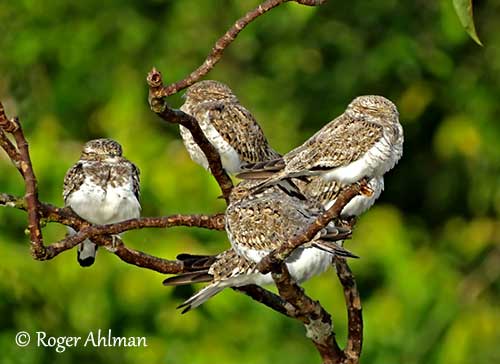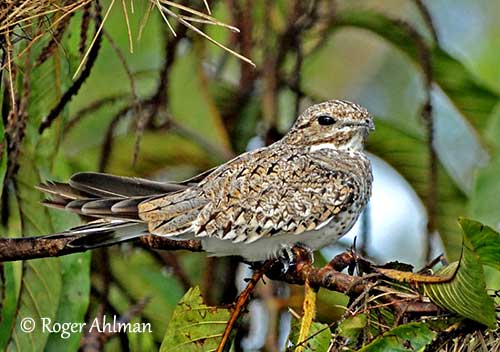
Fr: Engoulevent sable
Ang: Sand-coloured Nighthawk
All: Flußnachtschwalbe
Esp: Añapero Blanco
Ita: Succiacapre sabbia
Nd: Zandkleurige Nachtzwaluw
Sd: sandfalknattskärra
Photographers:
Roger Ahlman
Pbase Galleries Peru and Ecuador
Dubi Shapiro
Dubi Shapiro Photo Galleries
Text by Nicole Bouglouan
Sources :
HANDBOOK OF THE BIRDS OF THE WORLD Vol 5 by Josep del Hoyo-Andrew Elliott-Jordi Sargatal - Lynx Edicions - ISBN: 8487334253
NIGHTJARS - A Guide to Nightjars and Related Nightbirds – Nigel Cleere and Dave Nurney - Yale University Press - First Edition (August 11, 1998) - ISBN 10: 0300074573 / ISBN 13: 9780300074574
A GUIDE TO THE BIRDS OF COLOMBIA by Steven L. Hilty and William L. Brown - Princeton University Press – ISBN 069108372X
BIRDS OF VENEZUELA by Steven L. Hilty – Ed. Christopher Helm – ISBN: 0713664185
BIRDS OF PERU by Thomas S. Schulenberg, Douglas F. Stotz, Daniel F. Lane, John P. O’Neill, Theodore A. Parker III – Princeton University Press 2007– ISBN: 978-0-691-13023-1
Neotropical Birds – Cornell Lab of Ornithology
THE AVIANWEB - Beauty of Birds (Sibylle Faye)
Family Caprimulgidae
Summary cards
Sand-coloured Nighthawk
Chordeiles rupestris
Caprimulgiformes Order – Caprimulgidae Family
INTRODUCTION:
The Sand-coloured Nighthawk is widespread in the Amazon Basin where it is confined to the lowlands, mostly below 400-500 metres of elevation.
It differs from the nightjars of subfamily Caprimulginae by the long, pointed wings and the fairly long tail. The rictal bristles are shorter and more scattered. The species of genus Chordeiles in the subfamily Chordeilinae are the largest and the most widespread.
This nighthawk becomes active at dusk, but only periodically during the night. It is adapted to the life along sandbars and riverbanks of the large South American waterways. It feeds on insects caught in flight. They usually forage and roost in flocks. They can be seen in large groups, perched on branches over the water.
The Sand-coloured Nighthawk is threatened by egg collection for consumption in many regions. The population is apparently declining, but currently, the species is not globally threatened.

DESCRIPTION OF THE BIRD:
Biometrics:
Length: 19-24 cm
The Sand-coloured Nighthawk is a pale nighthawk. The upperparts are greyish-brown with brown and cinnamon mottling and streaking. On the upperwings, the wing-coverts are pale greyish-brown, cinnamon and whitish, conspicuously spotted with blackish star-shaped markings. Most of the flight-feathers are white with grey fringes, and the first four pairs of primary flight-feathers are grey. The white tail shows broad grey terminal band, but the central pair of rectrices is like the upperparts.
On the underparts, we can see a white throat-patch. The underparts are greyish-white with cinnamon tinge and brown spotting and barring. Belly and flanks are mostly white tinged buff.
The head is like the upperparts and appears relatively small.
The bill is blackish-grey. The eyes are dark brown. Legs and feet are greyish-brown.
Male and female are similar, and both have a large, white patch across the rear part of the wing, contrasting with the dark trailing edge and the grey wing-tips.
The immature is paler and duller than adults.
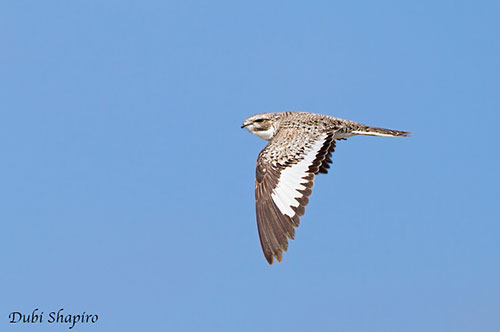
SUBSPECIES AND RANGE:
The Sand-coloured Nighthawk has two subspecies.
C.r. xyostictus is found in C Colombia (Cundinamarca). This race is sandier than nominate. It is presumably sedentary.
C.r. rupestris is found in NE Ecuador, NE Peru, SE Colombia (from Meta to Guainía) and S Venezuela, E through N and C Brazil, and S to C Bolivia.
HABITAT:
The Sand-coloured Nighthawk can be seen on rocky islands, sandbars and sandy beaches on rivers and marshes in rainforest, secondary growth and open forest. It also occurs in more open habitats such as lagoons, airfields and villages close to rivers. The species is usually present between the sea-level and 400-500 metres of elevation.
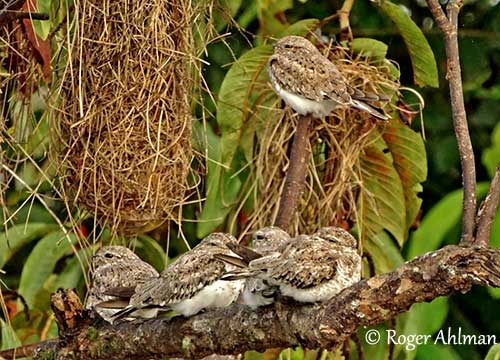
CALLS AND SONGS: SOUNDS BY XENO-CANTO
The Sand-coloured Nighthawk is usually quiet, but it has a fairly wide array of vocalizations. It utters a soft, purring trill while perched or during short flights “rrrr-wo-wo-wo”. We can also hear a growling, lower “gr’r’ow” and a bubbly “put-put-put-put-put-put”.
The territorial song is a guttural trilling followed by soft notes “gur’r’r’a’a’a’a-pü-pü-püü”. The roosting and nesting groups produce soft calls, but they are silent while foraging at dusk.
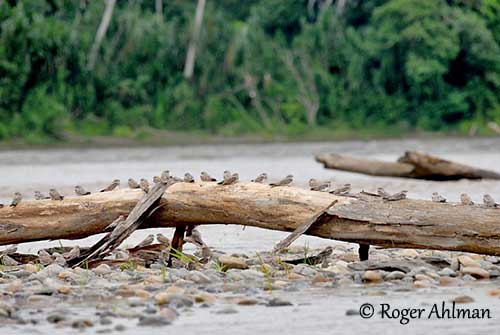
BEHAVIOUR IN THE WILD:
The Sand-coloured Nighthawk feeds on insects such as moths and termites, and probably other species. It forages in flight, in loose groups of up to 50 individuals or more. They fly low over sandbars, but higher over rivers, and can be seen swooping around the streetlights in villages.
They start foraging at dusk in loose groups of a few birds to several tens, typically flying off together to a distant river or lagoon where they can hunt for insects, flying rapidly back and forth at various heights. They usually forage actively during 15-30 minutes at dusk, becoming active only periodically during the night.
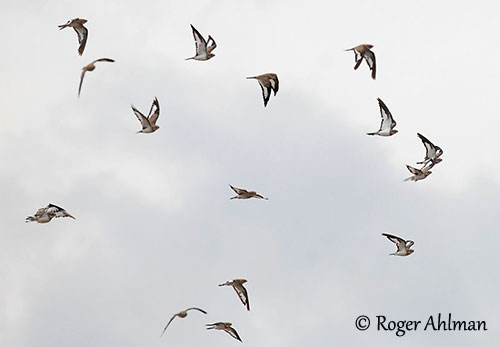
During the breeding season, the Sand-coloured Nighthawk performs courtship displays on the ground. The male stretches the neck up vertically and inflates the white feathers of the throat. It walks and approaches the female with fanned tail, swaying from side to side. Then, it stops abruptly and stretches its body horizontally, until touching the ground with the inflated throat. The tail is still fanned. The wings are usually raised during the displays, in order to expose the underwing pattern. Like other Caprimulgiformes, it nests on the ground.
The Sand-coloured Nighthawk may perform some local movements in some parts of the range. It is considered sedentary or partially migratory.
This species has long, pointed wings and forked tail. In flight, it resembles terns or waders while flying with deep wingbeats. The flight is less erratic than that of other nighthawks. It forages in short, fluttery flights near roost or nest-site.
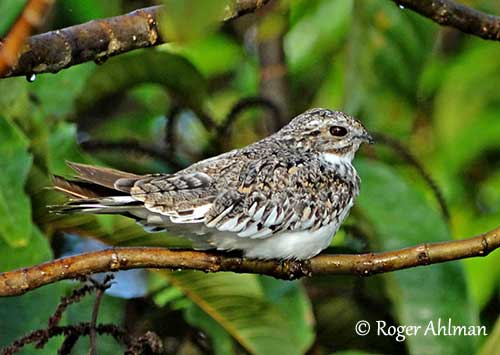
REPRODUCTION OF THIS SPECIES:
The breeding season occurs during the dry season in low-water periods. The Sand-coloured Nighthawk often breeds in loose colonies of up to 200 pairs, established on sandbars or beaches along rivers. The colonies are sometimes close to colonies of terns or waders (Black Skimmer), and the breeding success is usually higher in this case, because other species defend their nests aggressively.
The eggs are laid on the sand, and no nest is constructed. The female lays 1-2 sandy-buff eggs with brown markings. They are laid at 24 hours intervals. The incubation lasts 21 days.
Both eggs and chicks are vulnerable to various predators such as the Black Caracara, the Great Black Hawk, the Roadside Hawk, the Bat Falcon, snakes and iguanas, and sometimes the neighbouring Black Skimmer. In addition, the eggs are collected by humans.
The adults usually perform distraction-display if they are flushed from the nest. A replacement clutch may be laid if the eggs are lost by flooding or predation.
PROTECTION / THREATS / STATUS:
The Sand-coloured Nighthawk is locally common in suitable habitat along Amazon, Orinoco and Negro rivers.
Eggs and chicks are vulnerable to avian predation and humans. The population is suspected to be declining due to high level of exploitation.
But currently, the Sand-coloured Nighthawk is evaluated as Least Concern.
